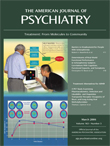Osteoporosis and Schizophrenia
To the Editor:
Martina Hummer, M.D., et al. (1) reported the occurrence of low bone mineral density in a group of young male subjects with schizophrenia. Levine et al. (2) and Applebaum et al. (3) reported elevated plasma homocysteine levels in young male schizophrenic patients.
Elevated homocysteine plasma levels were recently reported to be associated with osteoporotic bone fractures in the elderly in two large follow-up studies (4, 5). McLean et al. (4) analyzed blood samples obtained and stored from 1,999 men and women as part of the long-term Framingham Study. These researchers found that men and women in the upper quartile of homocysteine concentrations were nearly four and two times, respectively, as likely to later have a hip fracture in comparison to the lower quartile of homocysteine concentrations. Van Meurs et al. (5) analyzed blood samples and health data from 2,406 people. Men and women in the upper quartile of homocysteine concentrations were about twice as likely to have a hip or other bone fracture as were those in the lower quartile of homocysteine concentrations.
The mechanism underlying homocysteine’s effect on bone metabolism is not yet clear. However, several mechanisms were suggested, including that elevated homocysteine disturbs the cross-linking of collagen in bone and disturbs osteoblast formation (6).
Thus, it is suggested that elevated homocysteine levels may be a mechanism of the low bone mineral density reported by Dr. Hummer et al. (1) among young male subjects suffering from schizophrenia.
1. Hummer M, Malik P, Gasser RW, Hofer A, Kemmler G, Naveda RCM, Rettenbacher MA, Fleischhacker WW: Osteoporosis in patients with schizophrenia. Am J Psychiatry 2005; 162:162–167Link, Google Scholar
2. Levine J, Stahl Z, Ami B, Slava S, Ruderman GV, Belmaker RH: Elevated homocysteine levels in young male patients with schizophrenia. Am J Psychiatry 2002; 159:1790–1792Link, Google Scholar
3. Applebaum J, Shimon H, Sela BA, Belmaker RH, Levine J: Homocysteine levels in newly admitted schizophrenic patients. J Psychiatr Res 2004; 38:413–416Crossref, Medline, Google Scholar
4. McLean RR, Jacques PF, Selhub J, Tucker KL, Samelson EJ, Broe KE, Hannan MT, Cupples LA, Kiel DP: Homocysteine as a predictive factor for hip fracture in older persons. N Engl J Med 2004; 350:2042–2049Crossref, Medline, Google Scholar
5. van Meurs JB, Dhonukshe-Rutten RA, Pluijm SM, van der Klift M, de Jonge R, Lindemans J, de Groot LC, Hofman A, Witteman JC, van Leeuwen JP, Breteler MM, Lips P, Pols HA, Uitterlinden AG: Homocysteine levels and the risk of osteoporotic fracture. N Engl J Med 2004; 350:2033–2041Crossref, Medline, Google Scholar
6. Krumdieck CL, Prince CW: Mechanisms of homocysteine toxicity on connective tissues: implications for the morbidity of aging. J Nutr 2000; 130(2S suppl):365S-368SGoogle Scholar



